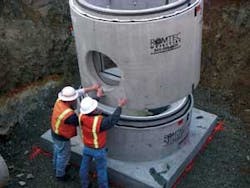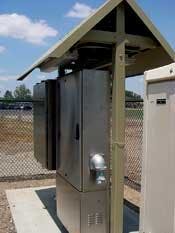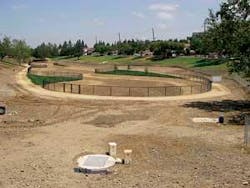by Megan Monson
Irvine Ranch Water District's innovative water treatment project, located in the city of Orange's El Modena Park, cleans urban runoff by filtering it through water plants and exposing it to the sun. The naturally treated water is then pumped into a storm drain, where it makes its way to upper Newport Bay and eventually into the Pacific Ocean.
The El Modena project is one of the first treatment sites completed for the ambitious San Diego Creek Natural Treatment System (NTS), a $41 million regional approach to treating urban runoff. The water district volunteered to take the lead on the NTS project, and is working with other public agencies and communities within the San Diego Creek Watershed to construct 31 water–quality wetlands to help clean urban runoff in central Orange County.
“The Natural Treatment System is an environmentally sound alternative for handling urban runoff,” said Randy Sundberg, project manager for the Irvine Ranch Water District (IRWD). The NTS master plan, he explained, consists of small manmade wetlands placed strategically throughout the watershed. Rain and urban runoff will be diverted to these sites, which will remove contaminants before they reach upper Newport Bay. At the same time, the system will provide riparian and wildlife habitat throughout the watershed.
Like many areas of the country, Orange County's landscape has changed a great deal in the last 40 or 50 years. Open farmland has been replaced by one of the country's busiest urban environments, with all of the buildings and paved areas that support it. Urban runoff –– excess water from washing cars, watering lawns and hosing down parking lots –– is a major source of pollution.
Even though areas such as El Modena Park are miles inland, water that runs through the park has a big impact on water quality in upper Newport Bay, and eventually the Pacific Ocean.
The El Modena Site
The regional Natural Treatment System is largely built around existing stormwater channels and flood control basins, along with wetlands constructed by developers in new communities.
At the El Modena site, the retrofit began with reconstruction of an existing basin. “It was an old water feature for El Modena Park that wasn't being used,” explained John Wolter, Inland Empire Division President for VA Consulting, an engineering firm that has been working with IRWD on constructed wetland and mitigation projects for more than 10 years.
The basin, built in the 1970s, consisted of green grass and a dirt pit near a flood control channel. Workers regraded the basin to create a pond with sloping sides and areas of open water 5 to 6 feet deep, and connected it to the channel.
The regrading improved a jogging track and created four flat areas suitable for picnickers — features much appreciated by park patrons.
“People are already calling the city of Orange to compliment the parks department,” Sundberg said. “It's quite rewarding for the neighborhood and beautifies El Modena Park.”
Workers also installed a flood control gate at one end of the pond and, at the other end, a lift station from Romtec Utilities Inc. (Roseburg, OR). The pre–engineered pump station, which arrived at the site pretested and ready to install, features a 6–foot–diameter wet well that is nearly 18 feet deep. The pump station, which controls the level of water, is located in the wetland area alongside the basin.
“Romtec provided a complete package so we didn't have to design a structural concrete vault and then put everything together,” Wolter said. “We talked with the engineers about flow rates, and sizes and other design criteria and they came back with recommendations. We ended up with a complete package that all came at once.”
How It Works
The treatment system uses the power of Mother Nature to clean the water. Jim Hyde, IRWD's environmental compliance specialist, explained it this way: Rain and urban runoff is redirected from the concrete flood control channel into the basin, the sloping sides of which have been planted with vegetation such as bulrush and cattails. These plants, along with bacterial action in the sediments and the ultraviolet action of the sun, help remove harmful compounds from the water.
When the water reaches a certain level, the lift station's pumps start and the control panel sends a radio signal to the slide gates instructing them to open. The “clean” water is thus moved out of the basin and into the nearby drainage channel, while the water level is maintained. The 1.2–million–gallon pond is sized so the water is cycled about every 14 days.
The level sensors in the lift station help keep the water at a precise depth, an important consideration for the plants.
“We have the pump station controls set to keep the water about a foot and a half to two feet above the vegetation benches,” Hyde said. “That's where the bulrush — the workhorse of the constructed wetlands environment — like it.”
During a storm event, the wetland may become inundated and the biofiltration vegetation completely flooded as the water level rises. The pump station is designed to be flooded during these occasions.
“If the water level in the basin is too high, the gate shuts and the pumps shut down; we use the controls in the lift station to preserve the integrity of the flood control basin,” Sundberg said.
In this way, the wetland is serving as a detention area during the storm event, which helps keep the local drainage system from overflowing. After the storm, the pumps are allowed to operate normally, draining the wetland to its intended “normal” level so the biofiltration function can continue.
“This is the first site that has used a lift station,” Sundberg said. “We don't usually have this volume of water to move, but we're looking at lift stations for other sites right now.”
The Irvine Ranch Water District is working on or has already completed 11 natural treatment sites in the San Diego Creek Watershed system, including El Modena. About 15 other basins are in various stages of design and construction and will be in service within the next year.
“The Natural Treatment System is one of the few programs like it anywhere in the country,” Wolter said. “The IRWD took the responsibility to help go back and retrofit existing systems. These constructed wetlands are a new kind of special treatment and we feel privileged to be involved.”
About the Author
Megan Monson, based in southern Oregon, is a public relations consultant for Romtec Utilities. She can be contacted at 541–863–5267, or via e–mail at [email protected].
The Irvine Ranch Water District
When officials in central Orange County began discussing a regional solution to treating urban runoff, the Irvine Ranch Water District volunteered to take the lead.
“Our district covers the entire San Diego Creek Watershed, all 118 square miles of it,” said Randy Sundberg, project manager for IRWD. “Our board volunteered us to step up and assist the counties and the cities in dealing with the natural treatment systems on a regional basis.”
The Irvine Ranch Water District has a track record of success in using wetlands for the treatment of urban runoff. The highly successful San Joaquin Marsh project, which the IRWD launched in 1995, has been credited with removing 950,000 pounds of nitrogen a year from San Diego Creek through a series of treatment ponds.
“The one thing we know more about than anything else is how to treat water,” Sundberg said.
Creation of the Natural Treatment System, while carrying a price tag of $41 million, is expected to save money in the long run as communities in the watershed avoid the expense of building new sewer infrastructure, or retrofitting existing sewers to handle urban runoff.
Besides providing effective treatment of urban runoff, “the natural treatment areas also give people wonderful wildlife and bird viewing areas,” Sundberg pointed out.







